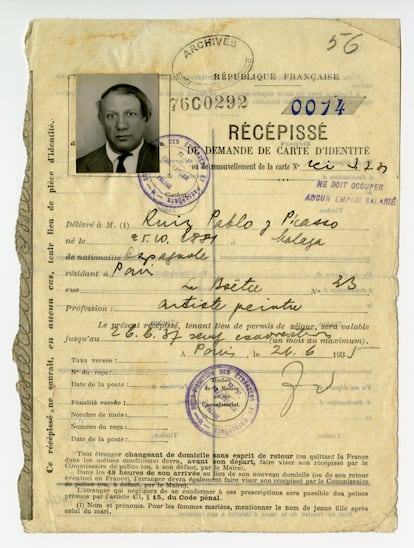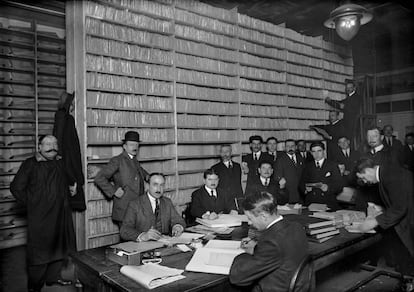Pablo Picasso, from suspicious foreigner to French national treasure
A book and exhibition on the Spanish-born artist show how he was placed under police surveillance before finally being adopted by the country that once refused him citizenship

It could be considered a flagrant case of cultural appropriation before the expression entered common use: the story of how the Spanish artist Pablo Ruiz Picasso ended up being one of France’s greatest artistic glories.
In reality, it was all rather more complicated than that. For decades, from the first time the Málaga-born genius visited Paris at the beginning of the 20th century, the French authorities were suspicious of him. He was placed under police surveillance, a file was opened on his activities and he never renounced his Spanish citizenship. The only occasion he sought French nationality was in 1940, on the eve of the Nazi occupation. However, his application was denied. After World War II, France worked hard to be reconciled with the creator of Les Demoiselles d’Avignon and Guernica, but by then Picasso had lost interest in acquiring French citizenship.
“France won Picasso back at the last minute,” says the historian Annie Cohen-Solal, author of the monumental essay Un étranger nommé Picasso (or, A foreigner named Picasso, published in France by Fayard), and curator of the exhibition Picasso, l’ étranger (or, Picasso, the foreigner), which opened on November 4 at the National Museum of the History of Immigration Paris. “The Musée Picasso was inaugurated in 1985 in the heart of Paris, a museum that erased everything that had happened before.”

What happened before forms the nucleus of the book and the exhibition: Picasso’s personal journey as a foreigner and an immigrant in France. Official documents and artworks explain and contextualize his relationship with the country where he spent his entire adult life but which, as Cohen-Solal demonstrates, only accepted and wanted to fully embrace him in his later years.
The exhibition and the book, although apparently dealing with the past, speak indirectly about contemporary France, riven by the debate over identity and where the far right has been garnering political support. The anti-immigration rhetoric too often forgets that France would not be what it is without migrants and that some of its greatest artistic, scientific and literary figures, who today are a source of national pride, were born outside the country. “France, like the United States, is a country of immigration, but immigration does not feature in the French national narrative as it does in that of the US,” says the historian Pap Ndiaye, director of the National Museum of the History of Immigration.

There are three key dates in the history of Paris and Picasso. The first is June 18, 1901. Picasso, who was still based in Barcelona, had not yet definitively settled down in the French capital but he had spent time there. The Vollard gallery put on an exhibition of his work. A show review in the newspaper Le Journal caught the attention of a police commissioner named Rouquier, who opened a file on Picasso on June 18 with a report that, given the artist’s friendship with Catalans living in Montmartre who had taken him under their wing, and the grisly themes of his work, concluded: “There are motives to consider him an anarchist.”
As Cohen-Salal explains: “The anarchists and the Catalans handed Picasso the keys to Paris, but he was caught in a trap: that report would hang over him for the rest of his life and was fed by new reports every time his name appeared in the press. There were three reasons why he was considered a suspicious person: first, he was a foreigner; second, he was considered an anarchist; and third, he was avant-garde in a country that was horrified by the avant-garde because in France the Academy of Fine Arts, the most conservative in Europe, ruled the roost.”
The second key date for Picasso in France was April 3, 1940. On that day Picasso, with his characteristic calligraphy, signed a request to become a nationalized Frenchman. He was by then a celebrity, the greatest artist of the 20th century, acclaimed in Paris and New York, a multimillionaire who had sided with the Spanish Republic and an avowed anti-Fascist, a living legend. Picasso also had the backing of various influential French public figures. But it was all in vain. In a four-page report, a deputy inspector general of the Police Prefecture named Émile Chevalier dug out the false accusation of Picasso’s anarchist association from 1901 and embellished it with more rumors and slander, concluding: “This foreigner does not meet any of the requirements for naturalization; on the other hand, and after what has been said, he must be considered as suspicious from the national point of view.”

Why did Picasso wish to take French citizenship? “What motivated him was not to be French, but to have certain rights at a precise moment in time,” says Cohen-Salal. “It was the days of ‘degenerate art’ in Germany, Franco was in power in Spain and the Nazis were on the doorstep of Paris. He feared ending up like [Federico] García Lorca, an atoning victim. He didn’t care at all about nationalities: before anyone else he had understood that he was a citizen of the world; he belonged to the Mediterranean sphere and engaged with art from all periods of history.”
A few weeks after seeing his application for French citizenship denied, Paris fell to Nazi Germany. France was occupied for four years, Inspector Chevalier held several positions of responsibility within the Vichy collaborationist regime, and Picasso... well, he continued to paint. In October 1944, after Paris was liberated, he found a new home: the Communist Party. And in 1947 he donated 10 works to French museums, which until that point had largely ignored him. “Today, the divorce between France and the genius comes to an end,” Georges Salles, director of the Museums of France, said with satisfaction. In 1948, the French government awarded Picasso a privileged residency card “on account of the personality of the person concerned.”
The pariah of 1901 who was for years subjected to police surveillance had “become a VIP,” the exhibition catalog reads. Cohen-Salal notes that in 1958, France finally offered Picasso citizenship: he turned it down. Ten years later he was awarded the Légion d’honneur, the nation’s highest order of merit, which he also refused to accept. He did not attend a huge exhibition of his work at the Grand Palais in Paris in 1966 and neither did he visit the one the Louvre dedicated to him in 1971, despite being the first living artist in history to be recognized with the honor.
It was a full-blown seduction operation orchestrated among others by the writer André Malraux, author of Man’s fate, who was cultural affairs minister from 1959 to 1969 under Charles de Gaulle. It was Malraux who in 1968 promoted a law that allowed for inheritance rights to be defrayed via the donation of valuable works of art to the state. “He did this for Picasso, and his donation was his work,” says Cohen-Salal. “And thanks to this, France was bestowed Picasso’s legacy.”
Picasso, who already had his own museum in Barcelona, was finally a French artist. “For me he was part of the French heritage, very Franco-French,” says Benjamin Stora, a former director of the museum and promoter of the exhibition, in the catalog. “When later I found out, I said to myself: ‘It can’t be possible! The most celebrated of all French painters isn’t French!’”
Tu suscripción se está usando en otro dispositivo
¿Quieres añadir otro usuario a tu suscripción?
Si continúas leyendo en este dispositivo, no se podrá leer en el otro.
FlechaTu suscripción se está usando en otro dispositivo y solo puedes acceder a EL PAÍS desde un dispositivo a la vez.
Si quieres compartir tu cuenta, cambia tu suscripción a la modalidad Premium, así podrás añadir otro usuario. Cada uno accederá con su propia cuenta de email, lo que os permitirá personalizar vuestra experiencia en EL PAÍS.
¿Tienes una suscripción de empresa? Accede aquí para contratar más cuentas.
En el caso de no saber quién está usando tu cuenta, te recomendamos cambiar tu contraseña aquí.
Si decides continuar compartiendo tu cuenta, este mensaje se mostrará en tu dispositivo y en el de la otra persona que está usando tu cuenta de forma indefinida, afectando a tu experiencia de lectura. Puedes consultar aquí los términos y condiciones de la suscripción digital.
More information
Archived In
Últimas noticias
Rowan Atkinson tops Netflix at 70: ‘He’s as funny as ever’
Israeli recognition of Somaliland stirs up the Gulf
Tiger Woods turns 50: Will he continue playing on the PGA Tour or take a back seat?
The surreal journey of James Nnaji, the Barcelona youth player selected in the NBA Draft who ended up in the NCAA
Most viewed
- Oona Chaplin: ‘I told James Cameron that I was living in a treehouse and starting a permaculture project with a friend’
- Reinhard Genzel, Nobel laureate in physics: ‘One-minute videos will never give you the truth’
- Sinaloa Cartel war is taking its toll on Los Chapitos
- Why the price of coffee has skyrocketed: from Brazilian plantations to specialty coffee houses
- Chevy Chase, the beloved comedian who was a monster off camera: ‘Not everyone hated him, just the people who’ve worked with him’











































